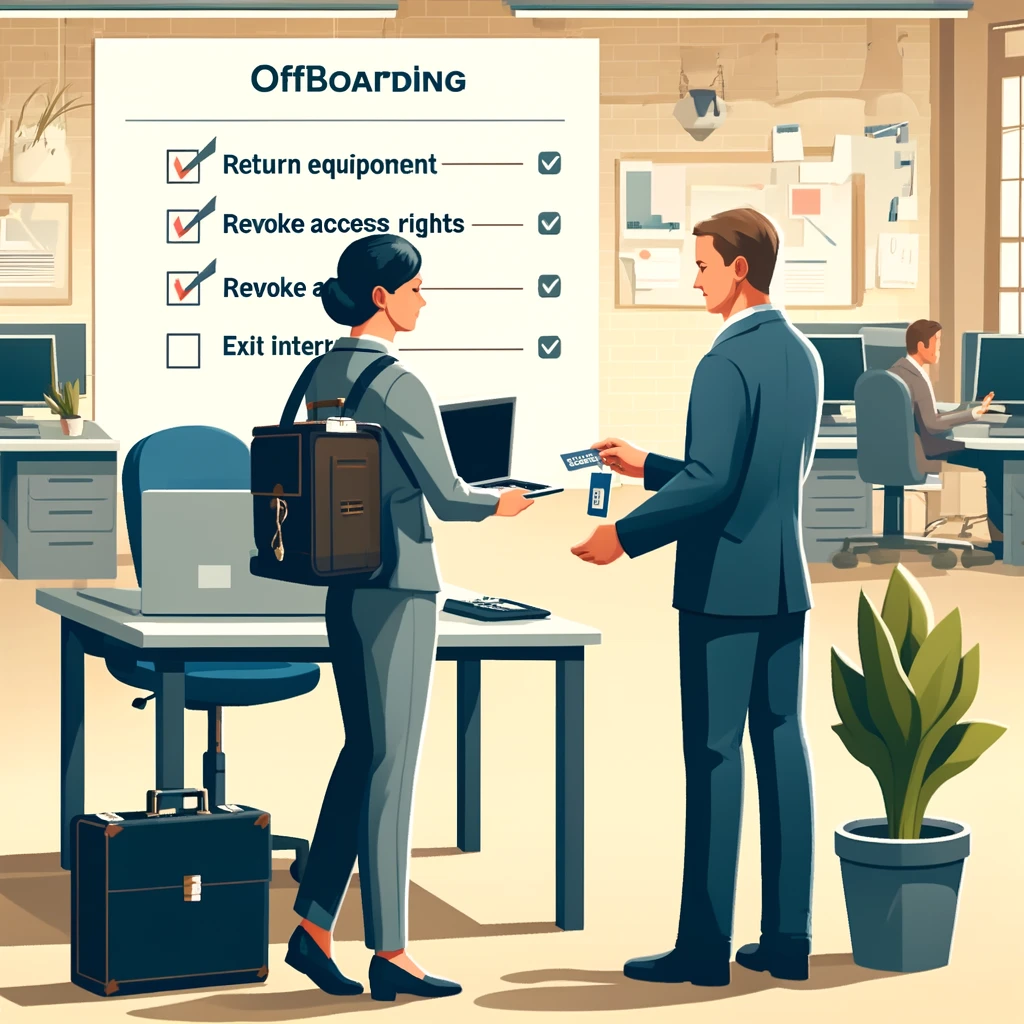
Offboarding Procedures refer to the systematic process of managing the transition of an employee out of an organization when they leave their position, whether due to resignation, termination, retirement, or any other reason. These procedures ensure that departing employees exit the organization smoothly and securely while protecting sensitive information, assets, and systems.
Key aspects of Offboarding Procedures include:
- Notification and Documentation: HR or the employee’s supervisor initiates the offboarding process by notifying relevant departments, such as IT, security, facilities, and finance, about the employee’s departure. Documentation, including resignation letters, termination notices, and exit interviews, may be collected for record-keeping and compliance purposes.
- Access Revocation: IT administrators revoke the departing employee’s access to corporate systems, applications, networks, and data to prevent unauthorized access and protect sensitive information. Access revocation may include deactivating user accounts, resetting passwords, removing user privileges, and disabling remote access credentials.
- Return of Assets: Employees are required to return any company-owned assets, equipment, devices, keys, badges, access cards, and intellectual property entrusted to them during their employment. Offboarding Procedures specify the process for returning assets, including instructions for returning equipment, collecting company-issued items, and retrieving access credentials.
- Data Security and Protection: Offboarding Procedures ensure the secure handling and disposal of sensitive data and information associated with the departing employee’s accounts, files, emails, and digital assets. IT staff may transfer ownership of files, archive data for retention purposes, or securely delete data from devices to prevent data breaches and compliance violations.
- Exit Interviews and Feedback: HR may conduct exit interviews or surveys to gather feedback from departing employees about their experiences, reasons for leaving, and suggestions for improvement. Exit interviews provide valuable insights for identifying organizational strengths and weaknesses, addressing employee concerns, and improving retention efforts.
- Knowledge Transfer: Departing employees may be required to transfer knowledge, responsibilities, and ongoing projects to their successors or team members to ensure continuity of operations and minimize disruptions. Knowledge transfer may involve documenting procedures, sharing documentation and resources, and providing training or mentoring to new employees.
- Final Payroll and Benefits: HR and payroll departments calculate the departing employee’s final paycheck, including accrued leave, bonuses, commissions, and benefits. They also provide information about COBRA benefits, retirement plans, and other post-employment benefits, ensuring that departing employees understand their rights and options.
- Exit Clearance and Formalities: HR or administrative staff complete exit clearance procedures, including obtaining signatures on exit forms, collecting company property, and confirming that all offboarding tasks have been completed. Employees may receive formal acknowledgment of their departure and any outstanding obligations or agreements.
- Legal and Compliance Obligations: Offboarding Procedures ensure compliance with legal requirements, contractual agreements, labor laws, and regulatory obligations governing employee termination and separation. HR professionals and legal advisors may review offboarding processes to mitigate legal risks and ensure fair and equitable treatment of departing employees.
By following comprehensive offboarding procedures, organizations can minimize security risks, protect sensitive information, maintain productivity, uphold legal and regulatory compliance, and preserve positive relationships with departing employees. Effective offboarding procedures contribute to a smooth and professional transition for both departing employees and the organization as a whole.

Penetra Cybersecurity is at the forefront of defending the digital frontier, providing cutting-edge solutions to protect businesses and organizations from the ever-evolving threats of the cyber world. Established with a mission to create a safer internet for everyone, Penetra leverages a blend of advanced technology, expert knowledge, and proactive strategies to stay ahead of cybercriminals.
Ready to take the next step towards a more secure future? Schedule a consultation with us today and discover how we can help protect what matters most to you. Don’t wait until it’s too late—with Penetra Cybersecurity, your business isn’t just secure; it’s imPenetrable.




